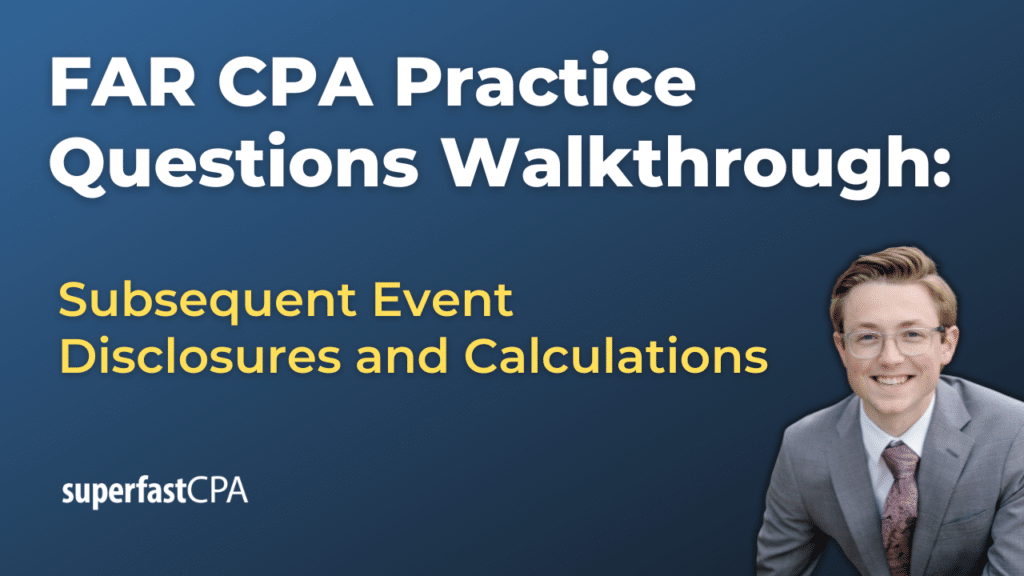In this video, we walk through 5 FAR practice questions about subsequent event disclosures and calculations. These questions are from FAR content area 3 on the AICPA CPA exam blueprints: Select Transactions.
The best way to use this video is to pause each time we get to a new question in the video, and then make your own attempt at the question before watching us go through it.
Also be sure to watch one of our free webinars on the 6 “key ingredients” to an extremely effective & efficient CPA study process here…
Subsequent Event Disclosures and Calculations
Subsequent events provide users of financial statements with information about significant events that occur between the balance sheet date and the date the financial statements are issued or available to be issued. Understanding how to classify and handle these events is vital for compliance with Generally Accepted Accounting Principles (GAAP).
What Are Subsequent Events?
Subsequent events are events or transactions that occur after the end of the reporting period but before the financial statements are issued (SEC filers) or available to be issued (non-SEC filers). These events can be classified into two categories:
- Recognized Subsequent Events (Type I):
Events that provide additional evidence about conditions existing as of the balance sheet date. These events require adjustments to the financial statements. - Nonrecognized Subsequent Events (Type II):
Events that relate to conditions that arose after the balance sheet date. These events do not require adjustments to the financial statements but must be disclosed if they are material.
When Does the Evaluation Period End?
- SEC Filers:
The subsequent events evaluation period extends to the date the financial statements are issued. “Issued” means they are widely distributed in a GAAP-compliant form. SEC filers do not need to disclose this date. - Non-SEC Filers:
The evaluation period ends when the financial statements are available to be issued. This means the financial statements are GAAP-compliant and all required approvals (e.g., board of directors) have been obtained. Non-SEC filers must disclose this date in the notes to their financial statements.
How to Account for Subsequent Events?
1. Recognized Subsequent Events (Type I)
If an event confirms conditions that existed at year-end, the financial statements must be adjusted to reflect the new information.
Example:
A lawsuit was ongoing as of the balance sheet date, with the likelihood of loss assessed as probable and an estimate available. After year-end but before issuance, the lawsuit is settled for an amount different from the estimate. The settlement amount should replace the estimate in the financial statements, and the event should also be disclosed in the notes.
2. Nonrecognized Subsequent Events (Type II)
If an event arises after year-end and does not reflect conditions that existed at the balance sheet date, no adjustments to the financial statements are made. However, material events must be disclosed in the notes.
Example:
A warehouse is destroyed by a fire on February 10, after the year-end date of December 31. The warehouse was fully operational and undamaged at year-end. While the event is material and must be disclosed (including the estimated financial impact), it does not affect the December 31 balances.
Common Scenarios and Examples
Here are some common scenarios to illustrate the application of subsequent event principles:
Scenario 1: Bankruptcy of a Key Customer
- Situation: A customer known to be in financial distress as of year-end files for bankruptcy shortly after year-end.
- Treatment: The bankruptcy confirms the customer’s financial difficulties as of year-end. A loss for the receivable must be recognized in the financial statements, and the event must be disclosed.
Scenario 2: Stock Issuance Post-Year-End
- Situation: A company issues $20 million in new stock on August 1, after a June 30 year-end, with no plans for the issuance at year-end.
- Treatment: This is a nonrecognized subsequent event. It does not reflect conditions existing at year-end, so no adjustments are made. However, the issuance must be disclosed due to its material impact.
Scenario 3: Flood Damage After Year-End
- Situation: A flood causes $2.5 million in damages to a facility in January, after a December 31 year-end. The facility was in good condition at year-end.
- Treatment: Since the flood occurred after year-end and does not reflect a pre-existing condition, no adjustments are made. Disclosure is required to inform users about the event and its financial impact.
Scenario 4: Settlement of a Lawsuit
- Situation: A lawsuit ongoing as of the year-end date is settled for a higher amount after year-end but before the financial statements are issued.
- Treatment: Adjust the financial statements to reflect the final settlement amount because it provides additional evidence about a pre-existing condition. Disclose the settlement in the notes for transparency.
Key Takeaways for Practitioners
- Always determine whether the event provides evidence about conditions existing as of the balance sheet date or arises from new conditions afterward.
- Recognize Type I events by adjusting the financial statements and disclosing them.
- Disclose Type II events if material, but do not adjust the financial statements.
- Understand the distinction between “issued” and “available to be issued” to determine the end of the evaluation period.













